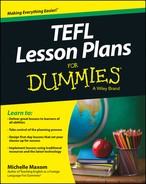Chapter 21
Dissecting Dictogloss
In This Chapter
![]() Understanding the benefits of dictogloss activities
Understanding the benefits of dictogloss activities
![]() Using dictogloss in a range of classes
Using dictogloss in a range of classes
![]() Planning a dictogloss lesson for a higher-level class
Planning a dictogloss lesson for a higher-level class
In this chapter, I discuss dictogloss: a kind of dictation activity in which students listen to and reconstruct a text . I explore the benefits, and show you how you can use dictogloss activities with your classes to promote listening, speaking, and writing skills as well as group communication. I also present an advanced lesson showing you how to use a news story as a dictogloss text.
Using Dictogloss as Lesson Content
You’ve heard of dictation, but perhaps you haven’t tried dictogloss. It’s somewhat similar to dictation but involves more skills. Here’s how it works:
- Introduce the topic that’s the subject of the text you will read.
- Pre-teach target language that will feature in the text.
- Read or play the text while students listen.
- Read or play the text again while students make detailed notes.
- Get students to review their notes individually.
- Break students into small groups to collaborate, using their notes to reconstruct the text.
- Review the student texts, focusing on the target language.
- Reveal the original text to the students for comparison.
Dictogloss activities have many advantages for students:
- Students can work both individually and as a group (and group work results in less pressure for each individual student).
- The objective of the activity is clear throughout.
- Reconstructing the text together results in more learner autonomy. They don’t depend on you for continuous feedback.
- Students teach and correct each other, which reinforces their learning.
- Students easily notice the difference between what they understand and what they need to say. This in turn highlights the areas of their learning that they need to improve on.
- You combine teaching and testing in the same activity, which is an effective use of time.
- Communication between students is authentic in nature: suggesting, confirming and negotiating are frequent aspects of everyday life.
- Dictogloss tests a broad range of skills including the ability to understand connected speech, instead of isolated words, and to apply syntax.
This lesson serves as an example of how to use dictogloss in your lessons. It’s best to choose a text that appeals to your own particular students. I based this lesson on crime following my students’ field trip to the law courts.
Lesson overview
Doing a warmer activity
![]() 5 minutes
5 minutes
Make a list of words that the students have learnt recently and note them down, one each, on slips of paper. Call a few students up to the board one by one. Hand each student a slip of paper and a board marker. Each student must silently draw (not write) a picture on the board within one minute that helps the rest of the class guess their word.
Introducing the topic
![]() 5 minutes
5 minutes
Draw a stick figure on the board dressed as a thief (mask, striped top, swag bag) and another of the figure in prison looking miserable. Ask the students to brainstorm all the stages between committing the crime and carrying out a prison sentence. They should suggest words like these:
arrested
went to trial
called a lawyer
verdict
questioned by police
guilty
charged
sentenced
Pre-teaching the language
![]() 5 minutes
5 minutes
Ask the students whether they know anything about the actress Lindsay Lohan. Elicit information from the class and explain that you’re going to read a BBC news article from November 2012 called ‘Lindsay Lohan Arrested at New York Night Club’. The article is about 260 words in length and you find it at http://www.bbc.co.uk/newsbeat/20545971.
Write on the board the names of any people and places in the article that the students would struggle to recognise or spell. This reduces students’ anxiety when they’re listening. So you may write the names of the areas in New York that are mentioned and the name of the film writer who features in the text.
Discuss the more difficult words: probation, allegation, and to clip someone with a vehicle. Put them on the board and elicit examples to clarify the meanings.
Delivering the text
![]() 8 minutes
8 minutes
Instruct the students to relax, concentrate and listen to your reading of the text. Read at a slow but normal speed, like a newsreader.
Now instruct the students to get their pens and notebooks ready. They must listen again very carefully and take detailed notes, rather than writing every single word. At the end of this second reading, give students two minutes to read through and edit their notes.
Collaborating in groups
![]() 15–20 minutes
15–20 minutes
Put the students into small groups of three or four. They now compare their notes and produce one version of the text per group written on a separate sheet. They should make their text as similar to the original as possible, although you don’t expected them to use exactly the same words throughout.
While the students discuss the text, monitor and note any difficulties the students are experiencing in sentence construction or vocabulary. You can address these points in the analysis stage. Make sure all the students are contributing and ask for opinions from anyone who hasn’t contributed.
After at least ten minutes of discussion, give the students a checklist so that they can check the content of their text. Table 21-1 shows an example recording all the events in the Lohan text.

Analysing students’ work
![]() 12 minutes
12 minutes
As space allows, put the students’ texts side by side on the board, wall, or desktop for everyone to see. Gather the students around to compare the texts. Highlight particular language points that students can improve on or learn from. For instance, draw attention to the use of passive constructions in the text that keep Lohan in focus rather than the law enforcers, like this one: ‘The star was arrested at 4am.’
Show students the original text and allow them time to read through it.
Doing a cooler activity
![]() 5 minutes
5 minutes
Make a list of celebrities who have been sent to prison and some who haven’t. Go for the celebrities the students will know. Have a true or false quiz. For example, see Table 21-2.
Table 21-2 Example Celebrity Quiz
|
Quiz Question |
True/False Answer |
|
Paris Hilton was in jail in 2007. |
True |
|
Michael Jackson went to prison in 2005. |
False, the verdict was not guilty |
Extension activities
Discuss other examples of celebrities who have been on the wrong side of the law. Divide the class into two groups to prepare either side of a debate on the question: ‘Is it fair to expect celebrities to be role models for others?’ Hold a class debate and then get the students to write an essay on the topic as homework.

 The dictogloss text needs to be short enough that you can complete the task and analysis within one lesson. Don’t use text that contains unknown words or grammar, because this is very disconcerting for the students. The class needn’t reconstruct the text word for word; they can use some synonyms. However, they need to understand the overall coherence of the text, rather than just isolated sentences.
The dictogloss text needs to be short enough that you can complete the task and analysis within one lesson. Don’t use text that contains unknown words or grammar, because this is very disconcerting for the students. The class needn’t reconstruct the text word for word; they can use some synonyms. However, they need to understand the overall coherence of the text, rather than just isolated sentences.